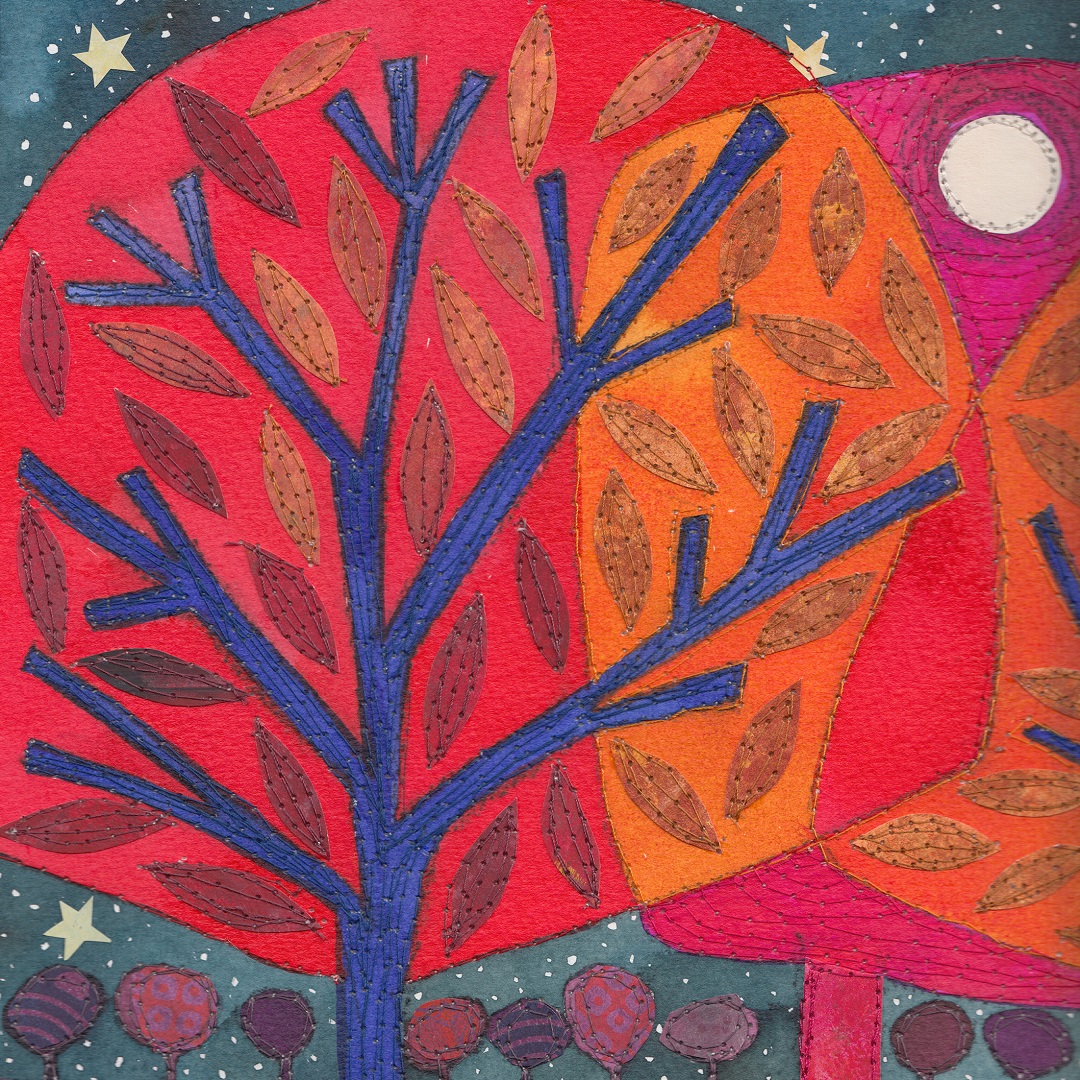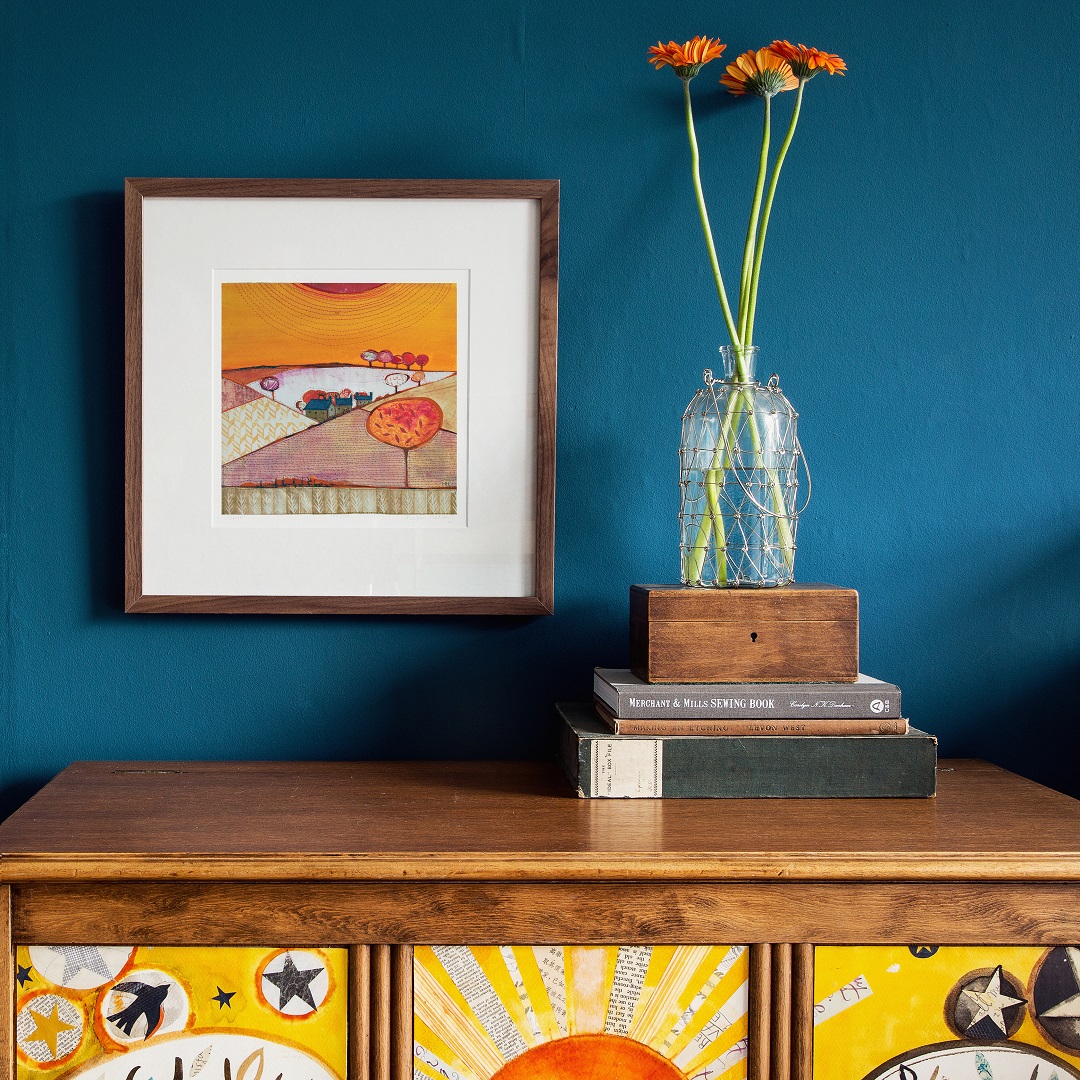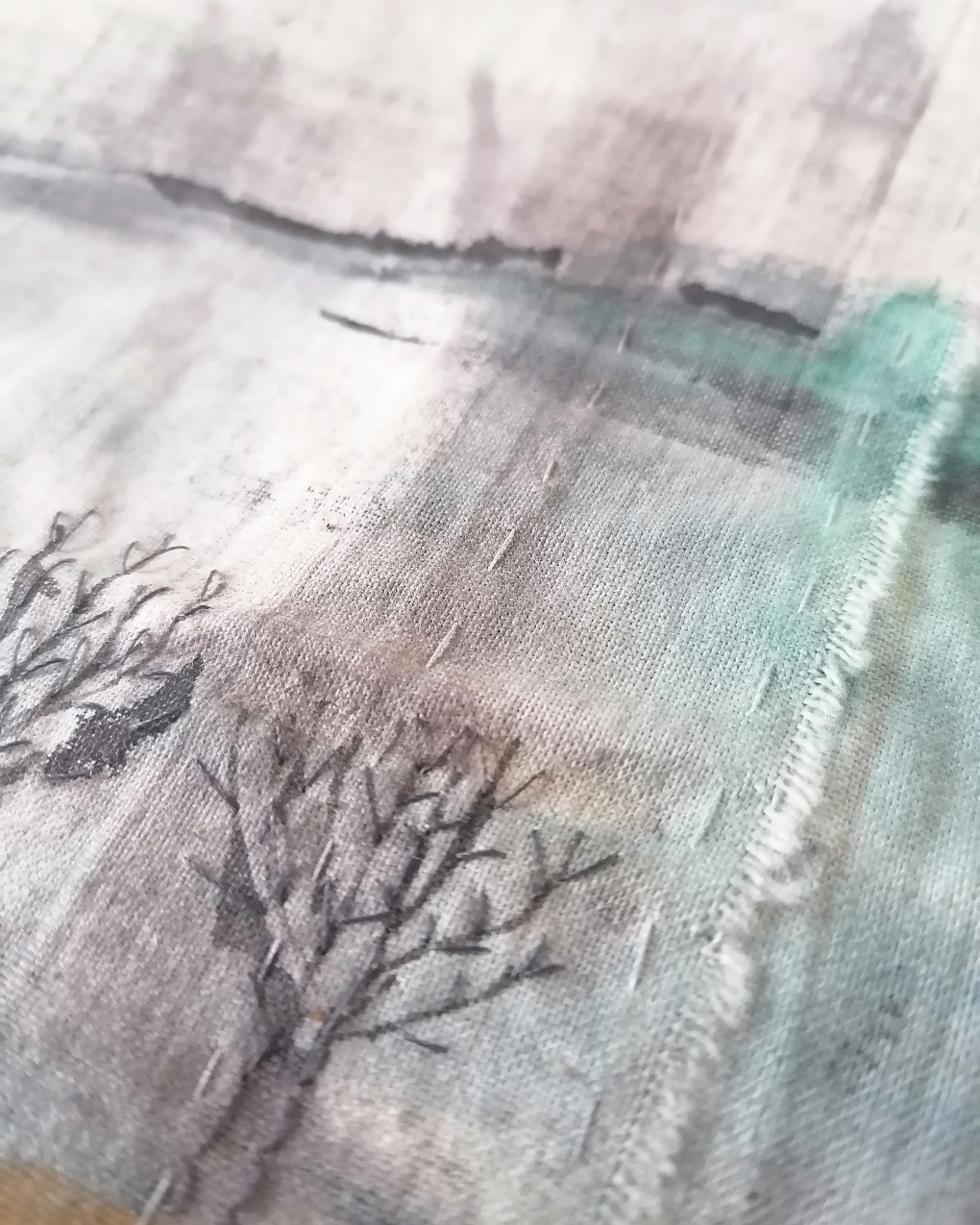When Helen Hallows looks out from her garden studio she sees squirrels, cats and birds, rolling hills and the rustic plots of her allotment… It nurtures her soul and provides a rich source of inspiration. For Helen, nature delivers a feast for the eyes, a cornucopia of materials, and is an eternal giver of goodies to nurture the soul – all of which can be translated into engaging works of art.
Listening to Helen, you sense an innocence in her spirit and a joy in her work, alongside a passion for sharing this with others. Her simple stitched art is inspired by folk art, and her mantra is ‘real not perfect’, revealing a down-to-earth perspective that endears her to her students. The fact that she dyes old bed sheets, and loves to buy men’s cotton shirts to reuse is perhaps another indicator of her unassuming/unpretentious/simple/unaffected approach to her practice.
Helen tells us about her path to becoming, in her words ‘an advocate for the human need to create and share beauty’ – creating from her soul as an artist, tutor and mid-life mentor. And when she’d worked with paper collages for many years, how the sensory comfort of sewing called her back to working with fabric.




A journey of self-acceptance
Helen Hallows: ‘Today, I am a confident, courageous creative, but I haven’t always been – it’s taken a long journey of self-acceptance. For a long time, I told myself I was ‘just’ a textile designer, ‘just’ a mum, ‘just’ made pictures – until I read The Artist’s Way by Julia Cameron and it gave me permission to connect to myself and to call myself an artist. As I’ve got older, and through having my family, I have accepted creativity as my purpose and realised that if I deny myself that, then I stop being me. I now teach and mentor others to help them to realise this too.
‘I work with mixed media, creating work inspired by the landscape and changes in nature. Within that is the sense of time and changing seasons and the change of night to day and dawn breaking. Nature is the beat of our lives and I find it healing. The pieces I create often feature symbols of the landscape: trees, houses or barns, and birds in flight.
‘The symbols I use in my work – sun, moon, star, tree, home – speak of our shared experience of the world and being human. I like to create art that invites reflection, connection and an appreciation for the wonders of nature. I have a purpose-built studio that looks out onto the garden; I love the peace of getting in there where I can watch the changing seasons.
‘I mostly use paper with collage and stitch, but, more recently, I’ve returned to my textiles roots (I trained in woven textiles) and am enjoying using fabrics in my work again. My work is becoming more abstract and I am enjoying using colour and mark more.
‘My work is sold as originals, prints and cards and I have self-published seven of my sketchbooks featuring works in progress, studio shots, and the textures and colours of my world.’


Becoming an artist
‘I come from a creative family where I was always encouraged. At the age of eight, I wanted to be a book illustrator. My mum taught me to sew and encouraged me to be creative, make and paint. My maternal grandmother painted and my paternal grandmother knitted and stitched. I lived abroad for a year at age four and, although I don’t remember it with great clarity, it filled my head with new places and people and I think that created a curious mindset.
‘My first shop was at age twelve – I sold brooches that I had made from Fimo at a craft fair. It gave me my first taste of making money by selling something I had loved making. That pleasure and excitement has never really gone away.
‘I went down an academic route at secondary school and was heading towards becoming an engineer when I realised I wanted to go to art college. So I did a transition year to get an art A-level before attending a fantastic foundation course which led me into a Textiles BA Hons at Loughborough College of Art and Design where I specialised in woven textiles. I loved every minute of my art education.
‘Following graduation I travelled around India and had my mind blown with the potential of life and the wonder of pattern and colour.
‘My biggest challenge has been building the confidence to sell my art. When I had my children and stopped working for a textiles agent I was struggling to find my own creative self and didn’t really believe I could sell my own work.
‘Putting some work in an open exhibition, selling it and being asked to create more started me on the journey to believe in myself.
‘Then it was a case of building my creative work and a creative business step by step.
‘Sketchbooks are fantastic spaces to explore. They’re a safe space and can be full of mistakes and try-outs. It’s in the ‘mistakes’ that I discover new ways of working and can push the boundaries of what I do.
‘I used to sketch in black and white – it was a huge leap going from that to creating my colourful artworks. Now I’m happy to work in colour, making the sketchbook my own with texture and colour before working into it. There are words in there, notes and affirmations. I usually choose a theme for a sketchbook and develop it into a project.
‘I decided to publish them because at workshops and selling events people were always really interested in seeing them and I realised they would get more inspiration taking one home than buying a few art cards. I hope the books inspire people to create and to notice the miracles of life.’


Bed sheets and men’s shirts
TextileArtist.org: Tell us about your process, from conception to creation.
‘Well that’s a big question for a mixed-media artist!
‘I sketch in nature, walk in nature and gather and collect her treasures. I take photos of colours and make compositions in my head that tell a story of place. Back in the studio, I sketch out ideas for images. These are then translated using paper or fabrics.
‘For paper-based work I work on watercolour paper, creating a painted background with acrylics and inks that I draw, collage and sometimes stitch into on a machine. The layers, textures (I create my own textured papers), patterns and lines all evoke the richness and ever-changing story of the landscape.
‘My fabric works are more abstract and more symbolic. I layer fabrics and add print, appliqué and stitch. I often work in series and take a few through to completion.
‘When I went from being a textile designer into creating my own landscape work for galleries I switched my materials from fabrics to papers. I liked the scope for colour and texture that papers gave me but I continued to use them in a fabric-based way akin to appliqué, and they’re often mistaken for cloth or leather. I add cut shapes on top of a painted background and use a machine to stitch the finished paper based piece to add more texture and fuse the layers.
However I missed working with cloth – there is a wonderful sensory comfort to sewing, especially fabrics with a patina of use. In lockdown, I had some time to play and connect with different materials and introduced some fabric strips into my paper-based landscapes. I also went the other way and started to experiment with adding paper onto textile backgrounds created from patched shirt pieces.
‘This interplay of cloth and paper, and the contrasts they bring, continues to fascinate me. I don’t like the ‘rules’ about what constitutes art versus craft. I also don’t think a piece has to be exclusively painted or stitched. I approach my work through creative play and discovery and see what happens. When working on paper, I add machine stitch and add pen marks that look like hand stitch. I use my machine without thread to add punch marks. On cloth I use hand stitch and create the same set of marks. I really enjoy the interplay of these processes.
‘When creating fabric-based work I love to repurpose vintage or second hand fabrics. I dye old sheets and love buying men’s cotton shirts to reuse. I use natural fibres, not synthetics, and prefer anything matt to shiny. I am not fussy about brands and am happy to use polycotton and embroidery thread gathered over the years, and not very tidily kept! I use acrylic paints a lot as well as emulsion tester pots and acrylic inks. I keep my products as ethical as possible – avoiding plastic and using UK printers for my prints, cards and books.’




The Nurtured Artist
Where did your title ‘The Nurtured Artist’ stem from?
‘That’s a good question. It grew from a sense of needing to be nourished before I can create. And that creating a piece that is visual art doesn’t mean it’s just about what you see. Creating art is holistic and needs all the senses to be engaged.
‘Living in a fast paced visual world, we can sometimes forget to slow, to stop, to breathe and to lean into the gentle experiences that nature offers us, to look out for stories to tell.’
‘Taking that holistic time, taking time to nurture and be nurtured gives us a solid base from which to create. Art becomes a meditation – the process more important than the end result. I give myself permission to play and to grow my art.
‘A day isn’t complete if I haven’t made something. So life is a balance of painting, cooking, sewing, knitting and growing. I have always been a thinker and love the big questions of What is art for? and What is life about?.
What do you teach in your online courses and what do you aim to achieve with your students?
‘Prior to the lockdowns I taught face to face workshops but in lockdown I created online courses and I’m proud to have reached new audiences to share my ideas and techniques.
‘There’s a strong focus on the sketchbook and I give permission to my students to use their own voice, to value their own experiences and where they are on the path to being a confident creative.
‘The courses are about creating a foundation of play and discovery, staying curious and also about releasing blocks and expectations of what art should be. With tasks and videos I encourage trial and error, with a focus on process rather than outcome. As soon as you start worrying about what the end piece will look like in a frame or on the wall, I find it all goes wrong!
‘Losing myself in the meditation of making garners the best results.’


Tell us a little more about your mentoring of art students.
‘I work with artists and makers, many of whom are turning their passion into a business and redirecting their life. I offer a sounding board and can hold them accountable for their dreams whilst providing grounded advice, rooted in my experience of 25 years as a self-employed designer/maker/artist. I hope to connect others to the simple pleasures of their daily life and share what it means to be alive.
‘It is really satisfying to be able to help others realise their potential and turn fears into achievements. Running a creative business takes a huge amount of dedication and a lot of skills above and beyond being a good artist or maker. I can advise and guide on how to create a structure for that business and set realistic goals.
Do you have one or two tips for makers?
‘It’s easy to become formulaic – especially once you have an audience for your work and feel the need to fulfil their expectations. I think having your own practice, rooted in play and curiosity, keeps you developing as an artist or maker.
‘I also think journaling has come to be a really powerful way that I stay in touch with myself and not be bombarded by all the imagery of social media that can knock us off kilter.’
‘For me, my work needs an emotional connection. I usually find that in a moment in the landscape, and then I try to capture that mood in colour and texture.’
Which direction do you think you’ll take in the future?
‘I can feel my work evolving towards the abstract and hopefully going bigger too. I am enjoying the feel of fabrics again and hope to develop that side of my work. In lockdown I did some hand loom weaving and would love to continue that journey. I also want to write more about how we develop ourselves creatively and the power of creativity for wellbeing.’













20 comments
Marjorie Fleat
This is so inspirational, Helen’s work has given me a new perspective and I’ll feel happy about ‘letting go’ of what is expected and what I feel and express in textiles. Thankyou so much Helen
Justyna
Oh my! As a developing artist and embroidery teacher I found a lot of myself and my beliefs in this article. It felt comforting to find so many things in common with you Helen – Artist’s way, nature, helping people break away from creative blockages. Wow! Thank you 🙂
Lesley Coles
I was recently introduced to Sketchbook Revival and have been busy exploring new ideas in paint as well as drawing, which I hope to include in my textile books I create. Reading this has encouraged me to to explore further, to continue playing and enjoying my creativity
Helen Hallows
I am so glad – keep exploring!
Chrys Hendi-Warner
I enjoyed reading this, Helen and have many of the interests. Your courses have helped me over the last 3 years. I wish I could have found you 25 years ago as that was when I needed the inspiration and guidance. Your art and your heart are beautiful, the way to guide & inspire your followers. Thank you.
Helen
Oh Chrys, thank you for your lovely comment. I enjoy seeing what you create and share. x
jeanne gray
oh helen. i am thrilled to have, yet again, another opportunity to learn from you
i have followed you for several years now
and to have you name yourself as the hunter-gatherer if nature couldnt be more accurate
looking forward to the lessons
thanks so much for sharing your gift
Helen Hallows
Thankyou Jeanne. I’ll look forward to seeing what you create!
Helen Hallows
Thank you. That’s a lovely comment!
Rachael Margeson
I’m really inspired by Helen’s approach and her work. I’m so looking forward to her workshop for Stitch Club this month!
Helen Hallows
I hope you enjoy it and get lots of ideas to take away.
Marlene Linton
Her work made me smile. I love the colours.
Helen
Hi Marlene! Thanks for your lovely comment. 🙂
Marlene
Her work made me smile. I love the colours.
Donna Pree
Love your work!
Helen
Thank you! 🙂
Dolores Grace
Her work reawaked in me the urge to create which had been sleeping in me for the last two years. Thank you,
Helen
I am so pleased that you feel inspired again 🙂
Clementine Cuppen
Sometimes one of your articles brings a smile to my face and a happy to my heart. It doesn’t happen very often, but this is definitely one of them. Off to her website I go!
Helen Hallows
Aw, that’s lovely to hear!